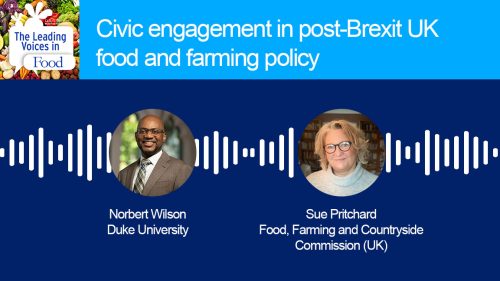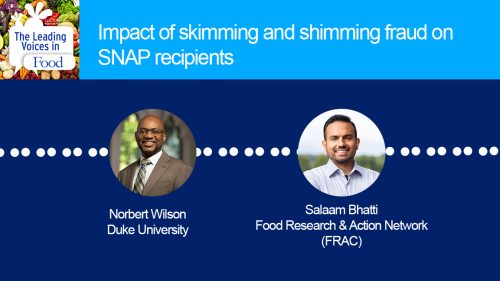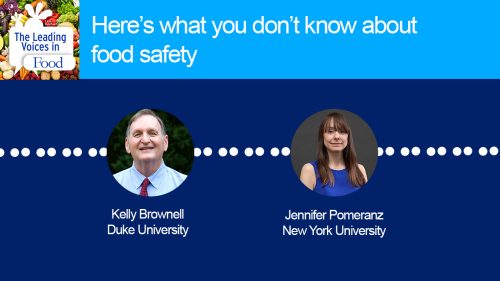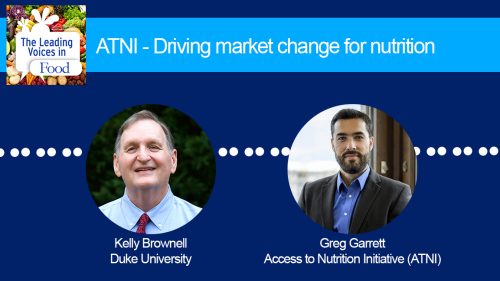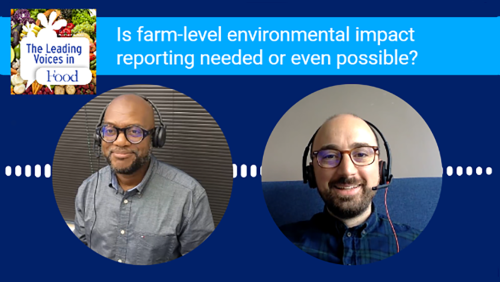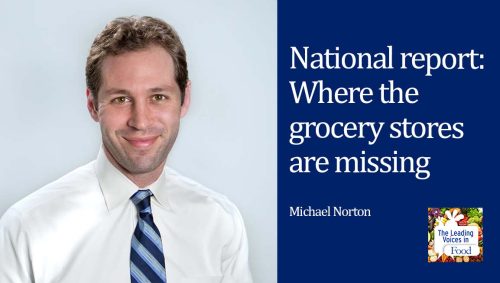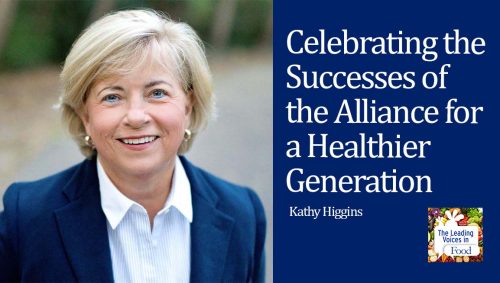The Leading Voices in Food
E126: Global Development Financing – What Can the Agriculture Sector Learn from Healthcare
If the world is ever going to end hunger, ensure food security and embrace sustainable agriculture practices, we’ve got to invest more in agriculture. Particularly, in developing countries. Now, governments and international organizations do invest in agriculture of course, but less than in healthcare, for example. And we wondered why? It turns out it’s not so much a question of why healthcare receives more funding, it’s how such funds are raised and distributed that makes a difference. In this podcast, we’re going to explore findings from our new report on agricultural development financing and highlight some innovative practices from healthcare sector that could be used to boost resources for agriculture in low and middle income countries. Our guests are global health policy professor Gavin Yamey of the Duke University Center for Policy Impacting Global Health and global health financing and policy expert, Marco Schaeferhoff of Open Consultants.
Subscribe: Apple Podcasts | TuneIN | YouTube Music | SoundCloud | PocketCasts | Radio Public
Tags: Agriculture & Tech | Food Policy | International Food & Ag Policy | Philanthropy & Food Systems |

Gavin Yamey MD, MPH, MA is the Director of the Center for Policy Impact in Global Health at Duke University. Yamey trained in clinical medicine at Oxford University and University College London, medical journalism and editing at the BMJ and public health at the London School of Hygiene and Tropical Medicine. He was Deputy Editor of the Western Journal of Medicine, Assistant Editor at the BMJ, a founding Senior Editor of PLOS Medicine, and the Principal Investigator on a $1.1 million grant from the Bill & Melinda Gates Foundation to support the launch of PLOS Neglected Tropical Diseases. In 2009, he was awarded a Kaiser Family Mini-Media Fellowship in Global Health Reporting to examine the barriers to scaling up low cost, low tech health tools in Sudan, Uganda and Kenya.
Marco Schäferhoff, PhD, is co-founder of Open Consultants. He combines over 15 years of management and consulting experience with in-depth expertise in global health financing and policy. An expert in development economics, Marco has led numerous projects involving benefit-cost analysis. He has worked in a range of development sectors, including health, education, nutrition, agriculture, and energy. Marco served as a member of The Lancet Commission on Investing in Health and has published widely on development financing and policy. He holds an advanced degree in Politics and a PhD in Political Science.
Interview Summary
Marco, in our report, we explore some of the reasons why ODA, official development assistance, increased so dramatically for healthcare. But first, could you help our listeners understand some of the big differences in development assistance for the health sector as compared to the agricultural sector?
Great question. So, what I would say is that the sheer amount of financing, official development assistance, for health and for agriculture are vastly different. If you look at the last 10, 20 years, agriculture ODA rose a little bit in absolute terms but as a share of total ODA, it remains rather flat. It’s about 4 percent of total ODA. In health, you have a completely different picture.
After the year 2000 up until roughly 2012, there was an enormous growth in development assistance for health from about 12 billion up to even 36 billion in 2012. This era between 2000 and 2012 was called the golden age global health financing. Despite the fact that there is already so much development assistance for health, it’s still growing. If you look at agriculture, this is a very different picture where you have maybe at 10 or 11 billion, and it’s very likely that we will see a decline in 2020 due to the COVID crisis.
In addition, the composition of agriculture ODA is also interesting. So if you look at the ODA provided by bilateral donor countries, like the US, or the UK, or Germany, about three quarters of all agriculture ODA in 2018 was bilateral ODA. In contrast, multilateral institutions, like the World Bank or EFR, only accounted for about a quarter. So, and relatively small share of all agriculture ODA. As a result of that, you have many small projects. So for example, the bilateral reported almost 14,000 aid activities for agriculture alone in 2018. And the average size of these projects and program was less than half a million. This is of course difficult from a recipient perspective, because you have many small projects which cause high transaction costs, and which are often also largely uncoordinated. So that’s one thing. In addition, if you look at the distribution of ODA loans versus 48 grants, you can see that about 35 percent of all agriculture ODA came in loans, and 65 percent came in grants, in 2018 again. So, first of all compared to 2017 levels, grantage fell by about 8 percent.
What is kind of interesting is that in the agriculture sector, multilateral funders tend to use loans but bilateral funders, primarily use grants. So what is striking is that in 2018, 80 percent of all multilateral agriculture ODA was provided by loans and only 20 percent in grants. The issue now compare this distribution with the health sector, you will see that exactly the opposite. So in health, about 80 percent of multilateral ODA comes in grants and only 20 percent in loans. What this shows is essentially that there is no large scale multi-lateral funder that provides grants for agriculture.
So during the time period in which healthcare development aid exploded, governments were working towards the UN’s millennium development goals or MDGs. Those goals created a focus for donor investment in low and middle income countries. And that’s a good segue for my next question to Gavin. What can the agricultural development financing sector learn from the health financing sector?
I think the health sector did very well on resource mobilization. Marco mentioned this term golden era where there was astonishing growth in health ODA. Really remarkable explosive growth, tripling of annual ODA for health. And it’s probably no surprise that when you look at where that went to it was for the MDGs for health. Right? So, child health, maternal health and HIV AIDS, TB and malaria. And this explosive growth in ODA for health was targeted particularly to those three goals. And I think what that tells you is health did well at saying, “We need to mobilize and have a clear financing plan for these particular priorities.” And that’s what happened.
How that happened is another lesson here for the ag dev sector. And that is, it was largely explained by the launch of new kinds of financing mechanisms. I think one of the things the health sector did well was to innovate in terms of the architecture of global health. So you started to see new entities forming that were mobilizing very large amounts of new financing. For example, the Global Fund to fight AIDS, tuberculosis and malaria, Unitaid – so-called innovative financing mechanisms innovative financiers that we’re able to mobilize large amounts of new dedicated financing for HIV, TB, malaria, vaccine preventable diseases and so on.
And it wasn’t just through traditional means that ODA was mobilizing. If you take UNITAID, for example, it has raised most of its funding, which is for HIV, TB and malaria, through a solidarity air ticket tax. So in about 20 or 30 countries that are members of Unitaid, when you buy an airline ticket, the taxes placed on that ticket and it’s used to fund Unitaid programs. And also a carbon tax. And I think the health sector has done well in using these new kinds of instruments: Airline solidarity, levies, vaccine bonds, for example, which turned long-term contributions by donors into immediately available cash. Advanced market commitments where agreements are made upfront, that if a global health technology is developed, they will be financing to buy it.
So there’s a range of innovative approaches that have been used in the health sector together with this sort of financing roadmap, a mobilization strategy, and a focus on multi-lateral rather than bilateral financing. All of which the ag dev sector I think could learn from.
So in our report, we highlight several ways to boost agricultural donor support such as innovative financing mechanisms, reforming the aid architecture, coordinating investment through a financing roadmap and shifting more support to multilateral organizations that pool money such as the World Bank. Marco, do you have anything else to add to that list?
Yes, I think it’s a great list. Maybe some quick nuances to this. So, one example Gavin mentioned the very important new mechanisms, these were deliberately created as grants based mechanisms. So the Global Fund to fight AIDS, TB and malaria or Gavi, the Vaccine Alliance were grant-based. Because before in global health, when it came to multilateral health finances, what the community realized at that point was that loans might not be the right way to tackle these diseases, especially HIV. So that’s important.
The second thing is that the growth in global health financing, to some extent was also fueled by the anxiety of the HIV pandemic at that time. So there was a securitization of HIV, and the Global Fund, for example, was supposed to be an HIV fund first and foremost, but then malaria and TB was added. So I’m saying that because MDG5, which was maternal health, and MDG4, which was child health, was a little bit neglected. And there was a realization that there was a lot of funding for MDG6. And at around 2008, 2009 there was a big discussion and debate about how to increase ODA for maternal and child health. And in that context, there was a very concrete multi-stakeholder effort to coordinate the field, and to raise funding for these specific purposes. And that was a global strategy for women, children and adolescent health. And that was a really important document which also included key indicators and the whole community really surrounded, and it really helped to coordinate the field and to raise financing.
So I think this is a very concrete example to Gavin’s point. And then finally we believe in the health sector that is the investments in what we call global public goods investments for example, in data. Data or needs, results, financing best practices, knowledge distribution functions, research, technical innovations. So there were quite a lot of investment, insufficient investment, but still quite a lot of investment into such global public goods. And we feel that such investment paid off based on very concrete data to say, who’s putting in money into global health at country level. What is the impact of an intervention? What is the benefit cost ratio of investing in health? So these kinds of data, metrics and research I think that was a very valuable investment. And to some extent, we also see this in other sectors but I would say the focus in health is really unprecedented and that is something that agriculture could also focus on more in the future.
So Marco, I’m curious then, what are the barriers for the agricultural development financing sector to make those shifts, to try to emulate the health sector financing?
So, I would say that overall there is a lot of potential for the agriculture sector to learn from health. Let me maybe just say that we do not want to idolize the health sector. It still has challenges, but I think it moved in the right direction in the past decade. Things like investments in global public goods, grant-based multi-laterals investments in new technologies and innovations, investments in data and metrics. All these things could be more emphasized in agriculture as well.
In terms of barriers, it is true of course, that in health we have seen a number of huge crisis. Gavin and I mentioned the HIV AIDS crisis, or the West African Ebola crisis, that really helped to increase the amounts and development assistance for health substantially. So I think much of what we suggest in the report could be applied to the agriculture sector as well. It’s probably true that in the health sector, the technological fixes might be a little bit more important. It’s very hard to develop vaccines, it’s hard to develop new drugs, it’s hard to distribute them, but we have very good tools and to some extent we do not have that in agriculture. But I think there’s still a lot of potential for R&D and innovations.
In addition, I would say that the current context, because of the COVID crisis, we will see a decline in ODA overall, but certainly for agriculture and other areas. We will see to what extent of the health sector will be affected. It might well be the case that we see another increase in health ODA. But the current context is a little bit difficult.
Another thing we found in our study is that there is quite a lot of fragmentation in the agriculture sector. So when it comes to coordination piece, that we suggested a concerted effort to finance agriculture, and that might be fairly hard to achieve simply because you have multiple bilaterals with different perspectives. I think if you look at the Europeans or the US, there is a difference in interests and perspectives. So that is something that would have to be figured out. We have few multilateral financers which sometimes collaborate with each other but often there is lack of foreign action.
So I think these things make the reform of the global architecture a little bit difficult, but to be honest, 20 years ago we faced very similar issues in the health sector. Overall, I do think that what we suggest in terms of innovative financing mechanisms data, multilateral grant funds saying these broad directions should and can be taken on board by agriculture.
Gavin turning to you, you talked a lot about innovative financing mechanisms in the health sector and how they could be applied to the agricultural development sector. I’m curious, what are typical barriers for setting up those types of innovative financing mechanisms that you could foresee?
As the name suggests, innovative, it requires stakeholders to think beyond traditional sources, right? So it requires new ways of thinking. It requires some kind of demonstration project or some at least pathway to seeing how an innovative financing mechanism could work.
So it’s often difficult to pilot these large scale initiatives, you know, but at least showing proof of principle, showing the potential investment case can be very helpful. If you look at some of the innovative financing mechanisms that you could argue have been successful, like Unitaid use of an airline ticket tax and a carbon tax. Those are the two sources of financing that Unitaid has used to raise very large volumes of financing for HIV, TB, and malaria. They were actually able to quite quickly demonstrate, you know, how much money could be raised. And they are a very significant player now in the HIV, TB landscape.
I think there is some skepticism around some of the less tried and true ways to raise money that are, you know, still being tested out, if you like. There’s been lots of talk for example, about tourist taxes. If, for example, you’re a tourist who goes to a malaria endemic region, there’s a lot of talk of an innovative tourist tax. You ask that tourist to pay $5 or $10 to enter the country and use it for malaria control. I haven’t seen those sorts of mechanisms take off yet. I know they were under consideration, for example for the Island of Zanzibar. And similarly, a lot of talk about using bonds, has been used successfully, I would argue in the vaccine space.
And then the last point I would probably make is, in my mind the most innovative thing we could be doing for global health financing, certainly for mobilizing financing for international collective action and global public goods like pandemic preparedness or research and development for neglected and emerging infectious diseases, would actually be a new kind of global pooled fund or perhaps a global tax. We haven’t really ever been able to go there, perhaps because of a general disquiet, a general lack of enthusiasm for a global tax. But I think post COVID-19, I don’t really see how we can get away from the notion that each nation is going to contribute according to its means towards, you know, some kind of pooled fund going forward. And there may be that sort of conversation happening around agricultural development financing as well.



